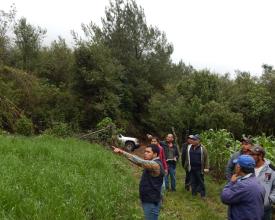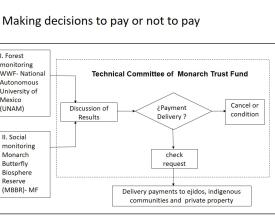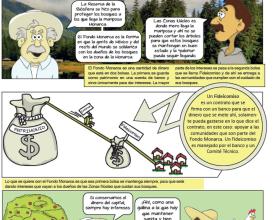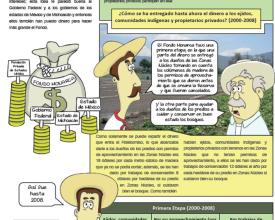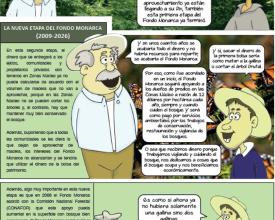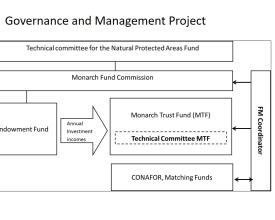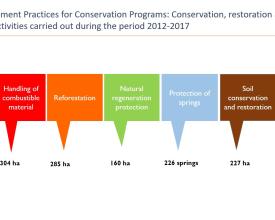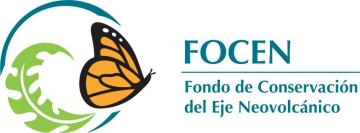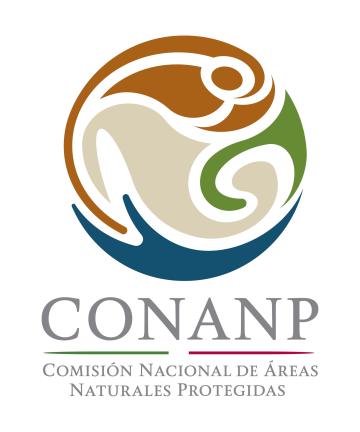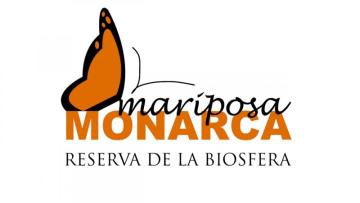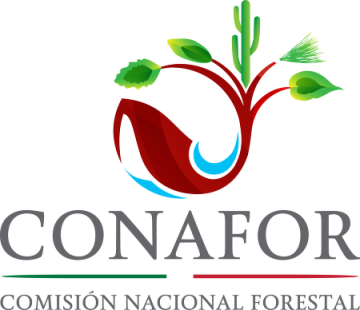Fondo Monarca: salvar a la mariposa monarca
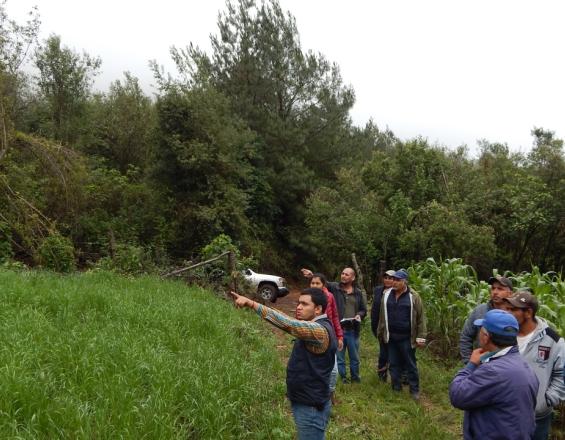
El Fondo Monarca (FM) es una estrategia de conservación basada en incentivos económicos para los propietarios forestales de la zona núcleo de la Reserva de la Biosfera Mariposa Monarca (RBMM). Comenzó con pagos por la transferencia de derechos de aprovechamiento forestal adquiridos antes de la publicación del decreto de la Reserva el 10 de noviembre de 2000. Los pagos por derechos de aprovechamiento forestal terminaron en 2008, lo que permitió la transición a un esquema de Pago por Servicios Ambientales (PSA) basado en la superficie conservada, incrementando el monto con aportaciones de la Comisión Nacional Forestal (Conafor).
El BM fue creado como un fondo patrimonial dentro del Fondo Mexicano para la Conservación de la Naturaleza (FMCN) con una aportación de 7.5 millones de dólares, este fondo patrimonial genera intereses anuales que se transfieren anualmente a un fideicomiso. Anualmente, el Comité Técnico del fideicomiso identifica las tierras que no han sido deforestadas y concede pagos a 34 comunidades.
Contexto
Défis à relever
Estudios científicos han demostrado que la mitad de la cubierta forestal mejor conservada de la Reserva de la Biosfera Mariposa Monarca (RBMM) se degradó durante el periodo 1971-1999, principalmente a causa de la tala ilegal. Por este motivo, se propuso al gobierno mexicano ampliar la zona núcleo de la Reserva y crear áreas protegidas contiguas para garantizar la protección del hábitat actual y potencial de la mariposa monarca y otras especies, así como el abastecimiento de agua a las comunidades.
El decreto de la nueva RBMM en el año 2000, implicó que el aprovechamiento forestal en la zona núcleo de la reserva se diera por terminado y no se permitiera en el futuro, por lo que fue necesario diseñar un mecanismo financiero permanente, el Fondo Monarca, que cubriera adecuadamente los intereses económicos de los propietarios de los bosques ubicados en la zona núcleo, incentivándolos a mantener los bosques en buen estado de conservación y cumplir con las disposiciones establecidas en el Programa de Manejo de la RBMM.
Ubicación
Procesar
Resumen del proceso
Existe un marco institucional claro que facilita el funcionamiento del Fondo Monarca sobre el terreno.
El FM forma parte del Fondo para Áreas Naturales Protegidas (FANP) del FMCN, una iniciativa público-privada entre el FMCN, el Gobierno de México y el Banco Mundial. El FANP consta de recursos patrimoniales, cuyos intereses se canalizan a 30 áreas naturales protegidas prioritarias del país.
El FANP cuenta con un Comité Técnico del FANP (CTFANP) que supervisa su operación, incluyendo el FM. Este Comité está integrado por siete miembros de diferentes sectores, quienes son designados por el Consejo Nacional de Áreas Naturales Protegidas y ratificados por el Consejo Directivo del FMCN.
Otro componente del FM es el Comité Técnico del Fideicomiso Fondo Monarca (CTFMM), que aprueba los pagos anuales a los ejidos y comunidades que han cumplido con la conservación de la cubierta forestal en las zonas núcleo. En el CTFMM participan seis representantes de ejidos, comunidades indígenas y propietarios privados.
Bloques de construcción
Un marco institucional claro a través de la colaboración público-privada
El Fondo Monarca (FM) forma parte del Fondo para Áreas Naturales Protegidas (FANP) del FMCN, una iniciativa público-privada entre el FMCN, el Gobierno de México y el Banco Mundial. El FANP se compone de recursos patrimoniales, cuyos intereses se canalizan a 30 áreas naturales protegidas prioritarias del país.
El FANP cuenta con un Comité Técnico del FANP (CTFANP) que supervisa su funcionamiento, incluido el BM. Este Comité está integrado por siete miembros de diferentes sectores, quienes son designados por el Consejo Nacional de Áreas Naturales Protegidas y ratificados por el Consejo Directivo del FMCN.
Otro componente del BM es el Comité Técnico del Fideicomiso Fondo Monarca (CTFMM), que aprueba los pagos anuales a los ejidos y comunidades que han cumplido con la conservación de la cubierta forestal en las zonas núcleo. En el CTFMM participan seis representantes de ejidos (propiedades agrícolas y forestales de uso colectivo), comunidades indígenas y propietarios privados.
Factores facilitadores
Este logro ha sido resultado del trabajo coordinado de la autoridad ambiental federal, los gobiernos de los estados de México y Michoacán, FMCN, WWF, los ejidos, comunidades indígenas y propietarios de las zonas núcleo que apoyaron el establecimiento del Fondo Monarca y el apalancamiento de Fondos Concurrentes para duplicar el pago por hectárea conservada en las zonas núcleo de la RBMM.
Lección aprendida
El MF sienta un precedente en México por ser el primer fondo de dotación cuyos intereses apoyan directamente a largo plazo a los propietarios de un área natural protegida federal.
Refuerzo de las capacidades locales en materia de financiación de áreas protegidas
Por otro lado, el Fondo Monarca (FM) fortalece las capacidades locales de 33 ejidos y comunidades para cumplir con las condiciones fiscales y bancarias relacionadas con los pagos anuales de conservación bajo la modalidad de fondos concurrentes. En colaboración con Conafor, Conanp, FMCN y asesores forestales, el FM apoya el desarrollo de 29 Mejores Prácticas de Manejo para Programas de Conservación (BMPCP, por sus siglas en inglés). Las BMPCP pretenden ser un documento que oriente la implementación de actividades encaminadas a la conservación de los ecosistemas forestales, con el fin de mantener o mejorar la provisión de servicios ambientales dentro de las áreas bajo incentivos financieros. Además, los BMPCP tienen la finalidad de que los beneficiarios puedan obtener recursos de otros programas gubernamentales para realizar las actividades propuestas en ellos.
Factores facilitadores
Para fortalecer la estrategia del MF dentro de los ejidos y comunidades, el Coordinador del MF acompañó el diseño de materiales de difusión con información sobre la nueva etapa del MF .
Finalmente, el FMCN, en coordinación con el Servicio Forestal de los Estados Unidos y la Red Monarca, apoya actividades complementarias de conservación en las zonas núcleo en materia de manejo del fuego, monitoreo del agua, protección contra incendios y restauración de áreas degradadas.
Lección aprendida
Como se propone en el estudio de caso Financiación para la conservación de los bosques y la biodiversidad en la Reserva de la Biosfera Mariposa Monarca: el Fondo Monarca, en el futuro se debe mantener el reconocimiento de que los bosques juegan un papel esencial en la generación de los servicios ambientales que presta la RBMM, por lo que la conservación de las zonas núcleo es un componente muy importante. Sin embargo, debe quedar claro que "el mantenimiento de los servicios ecosistémicos también requiere asegurar el uso sustentable del territorio en todo el área natural protegida y su área de influencia inmediata"
Recursos
Impactos
1. El Fondo Monarca (FM) sienta un precedente en México por ser el primer fondo patrimonial cuyos intereses apoyan directamente a largo plazo a los propietarios de tierras de un área natural protegida federal.
2. Los acuerdos institucionales a largo plazo dan a las comunidades confianza y transparencia en el uso de los recursos. Estos dos elementos son esenciales para reducir la degradación forestal y la deforestación. Además, contar con un fondo patrimonial ha permitido asegurar recursos adicionales de la Conafor por un periodo de 18 años (2009 - 2026).
3.Con los fondos de contrapartida, los propietarios de bosques reciben 683 pesos mexicanos por hectárea durante 18 años.
4. El impacto de la tala ilegal en el hábitat de hibernación en la Reserva de la Biosfera Mariposa Monarca (RBMM) ha disminuido significativamente. Este logro es resultado del esfuerzo coordinado de la autoridad ambiental federal, los gobiernos de los estados de México y Michoacán, FMCN, WWF, ejidos (propiedades agrícolas y forestales de uso colectivo), comunidades indígenas y propietarios privados de tierras.
5.El análisis de fotografías aéreas e imágenes satelitales muestran que entre 2003 y 2009 hubo una recuperación de 722 hectáreas de bosque en zona núcleo de la RBMM.
6. En 17 años la inversión total del BM ha alcanzado cerca de 54.8 millones de pesos mexicanos a ejidos, comunidades indígenas y propiedades privadas.
Beneficiarios
34 ejidos, comunidades indígenas y propietarios privados de tierras que participan en el Fondo Monarca.
Objetivos de Desarrollo Sostenible
Historia
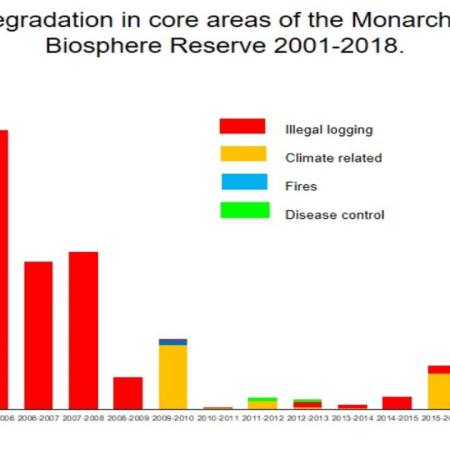
Una compleja combinación de amenazas ha contribuido al deterioro del fenómeno migratorio de la Mariposa Monarca a lo largo de los años. Sin embargo, las reuniones científicas trilaterales indican que las principales amenazas para la Mariposa Monarca en Norteamérica son:
- Impacto del uso de glifosato en la planta huésped de la mariposa monarca y su efecto en el declive de la población de la mariposa.
- Impacto de la tala ilegal en el hábitat de hibernación en la Reserva de la Biosfera de la Mariposa Monarca.
- Impacto de las condiciones meteorológicas adversas y el cambio climático.
De las amenazas identificadas por los expertos, el impacto de la tala ilegal en el hábitat de hibernación de la Reserva de la Biosfera Mariposa Monarca (RBMM) ha disminuido significativamente. Así lo demuestran los resultados del seguimiento anual del cambio de cobertura en las zonas núcleo de la RBMM bajo el Fondo Monarca (FM).
Este logro ha sido resultado del trabajo coordinado de la autoridad ambiental federal en México, los gobiernos de los estados de México y Michoacán, FMCN, WWF y los ejidos (propiedades agrícolas y forestales de uso colectivo), comunidades indígenas y propietarios de las zonas núcleo que apoyaron el establecimiento del Fondo Monarca y el apalancamiento de Fondos Concurrentes para duplicar el pago por hectárea conservada en las zonas núcleo de la RBMM.
Los datos científicos revelan que el BM ha logrado reducir las tasas de degradación y deforestación en la RMG. Honey-Roses et al (2011) encontraron pruebas de que la combinación de la protección legal de la zona (decreto de área natural protegida) y los incentivos financieros proporcionados por el BM han favorecido la conservación de los bosques de invernada de la mariposa monarca. Estos autores estiman que, aunque el 9% de las zonas con prohibición de tala se han deforestado desde 1993 y el 15% de los bosques densos han desaparecido, la pérdida habría alcanzado un 3% y un 11% adicionales, respectivamente, sin la existencia de estos instrumentos de protección e incentivos. El estudio hace una comparación detallada con la dinámica observada en las zonas circundantes que no disponen de estas herramientas.
Estos resultados son un claro indicio de que los mecanismos financieros de apoyo a la conservación, coordinados con el trabajo de muchas instituciones que persiguen el mismo objetivo, son una parte esencial de la fórmula para reducir la deforestación.
El FM sienta un precedente en México por ser el primer fondo patrimonial cuyos intereses apoyan directamente a largo plazo a los propietarios de un área natural protegida federal.
